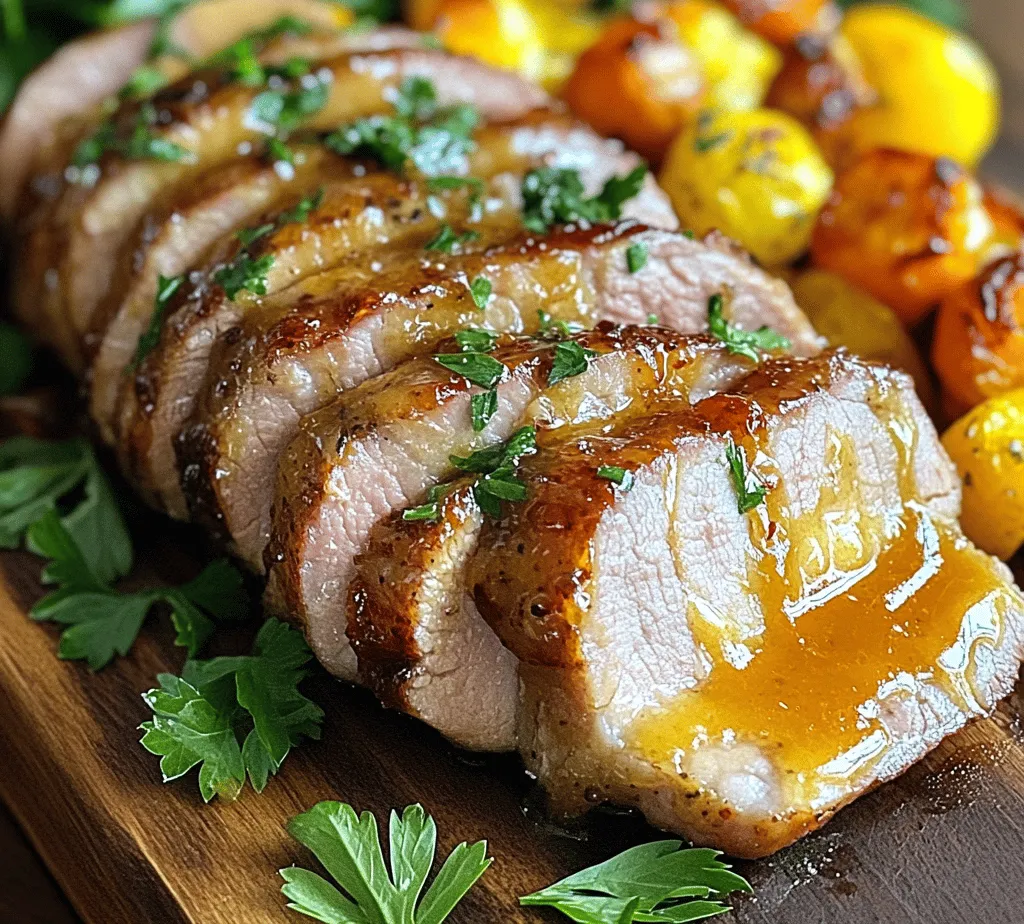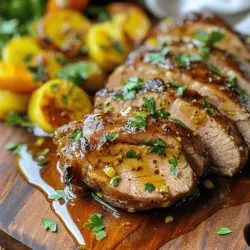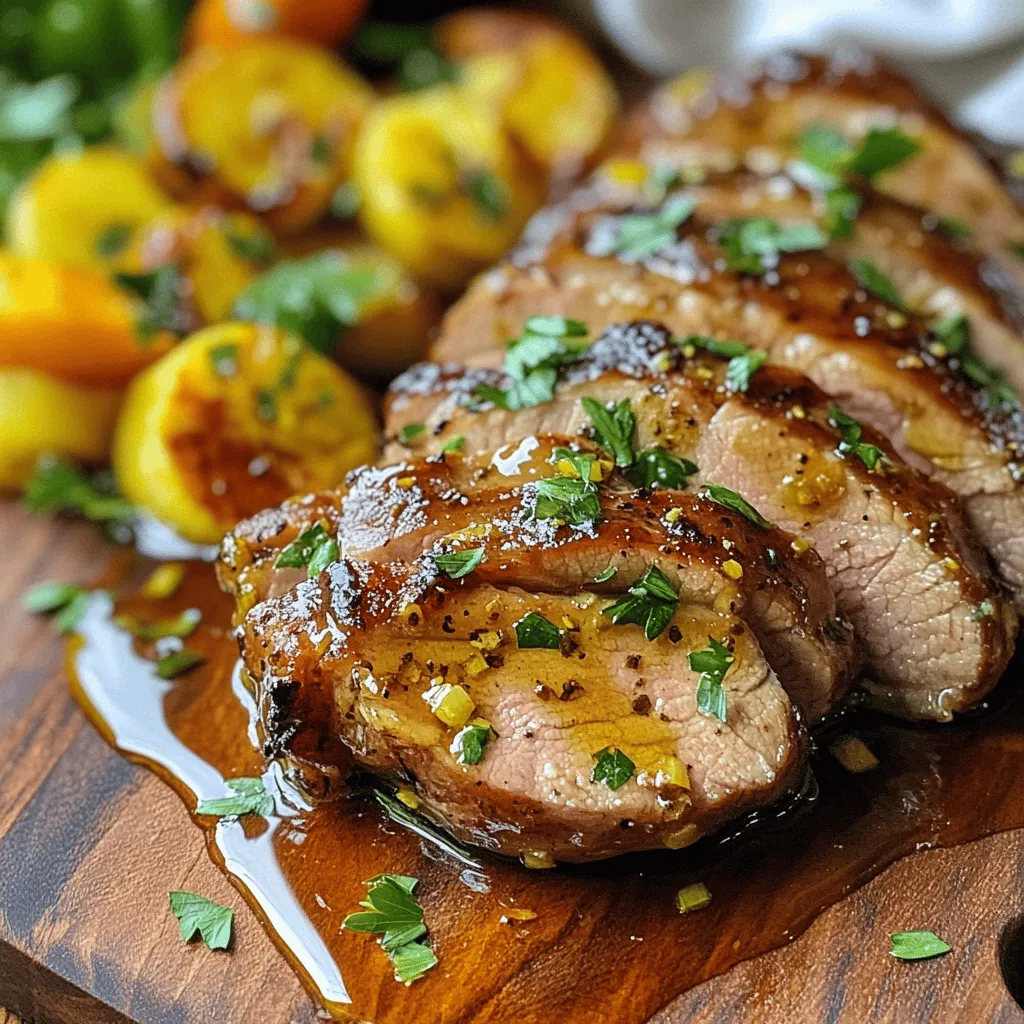Introduction
If you’re looking for a dish that marries sweet and tangy flavors while offering a satisfying and healthy protein option, look no further than Maple Mustard Pork Tenderloin. This delightful recipe showcases the tender, juicy qualities of pork tenderloin, expertly complemented by a rich marinade that features the natural sweetness of maple syrup counterbalanced by the sharpness of Dijon mustard. Whether you’re hosting a dinner party or simply treating yourself to a delicious home-cooked meal, this dish promises to impress with its vibrant flavors and beautiful presentation.
Pork tenderloin is a versatile cut of meat that can easily take center stage on your dinner table. Its mild flavor allows it to absorb marinades and seasonings beautifully, making it a favorite protein choice across many cuisines. From barbecuing to roasting, the possibilities are endless. The combination of maple syrup and Dijon mustard not only adds a layer of complexity but also enhances the natural sweetness of the pork, resulting in a dish that is both comforting and sophisticated. Let’s delve into the ingredients that make this dish a must-try.
Understanding the Ingredients
Pork Tenderloin: A Lean Protein Choice
Pork tenderloin is not only incredibly flavorful, but it is also one of the leanest cuts of pork available. With minimal fat content, it offers a healthful alternative to other meats while still providing the necessary protein to fuel your body. Nutritionally, pork tenderloin is packed with essential vitamins and minerals, including B vitamins, zinc, and potassium, which support energy metabolism and immune health. Its tender texture makes it a popular choice for various dishes, and its mild flavor profile allows it to pair beautifully with both savory and sweet ingredients.
When selecting pork tenderloin at the store, look for cuts that are pinkish-red in color with a small amount of marbling. Avoid any that appear excessively dry or discolored. Freshness is key, so purchasing from a reputable butcher or grocery store that practices good meat handling is advisable. If possible, opt for pork that is labeled as organic or pasture-raised for the best quality.
The Flavor Profile of the Marinade
The marinade serves as the heart of the Maple Mustard Pork Tenderloin recipe, infusing the meat with robust flavors that will tantalize your taste buds. Each ingredient contributes to the overall profile, creating a harmonious balance that highlights the pork’s natural qualities.
Maple Syrup: Sweetness and Depth
Maple syrup is the star ingredient in this marinade, providing a rich sweetness that caramelizes beautifully during cooking. Not only does it add flavor, but it also helps to create a glossy finish on the tenderloin. When choosing maple syrup, opt for pure maple syrup rather than imitation syrup to ensure the best flavor and quality. The depth of flavor in maple syrup enhances the dish, making it comforting and inviting.
Dijon Mustard: A Tangy Contrast
Dijon mustard brings a delightful tanginess to the marinade, cutting through the sweetness of the maple syrup. This balance is essential for elevating the overall taste of the dish. The sharpness of Dijon mustard complements the pork, enhancing its flavor while adding an aromatic kick. Additionally, Dijon mustard is known for its smooth texture, which helps the marinade adhere well to the meat.
Apple Cider Vinegar: Brightness and Acidity
Adding a splash of apple cider vinegar introduces a tangy brightness to the marinade. The acidity helps to tenderize the pork while enhancing the flavors of the other ingredients. Apple cider vinegar also adds a layer of complexity to the dish, balancing the sweetness of the maple syrup and the richness of the pork.
Olive Oil: Enhancing Flavor and Moisture
A drizzle of olive oil in the marinade not only helps to coat the pork evenly but also adds richness and moisture during cooking. Olive oil is known for its heart-healthy fats and is an essential ingredient in many marinades, as it helps to enhance the overall flavor and texture of the dish.
Garlic and Thyme: Aromatic Components
Garlic and thyme are essential aromatics that elevate the flavor profile of the marinade. Fresh minced garlic adds a pungent, savory note, while thyme contributes a subtle earthiness that pairs beautifully with the other ingredients. Together, they create a fragrant base that enhances the overall sensory experience of the dish.
Spices: Salt, Pepper, and Smoked Paprika for Depth
Finally, a touch of seasoning goes a long way in amplifying the flavors of your marinade. A pinch of salt enhances the natural flavors of the pork, while freshly ground black pepper adds a hint of heat. Smoked paprika introduces a smoky depth, making each bite of the Maple Mustard Pork Tenderloin truly unforgettable.
Step-by-Step Instructions for Perfect Maple Mustard Pork Tenderloin
Now that we’ve explored the key ingredients that make this dish so special, let’s move on to the step-by-step instructions for preparing your Maple Mustard Pork Tenderloin.
Preparing the Marinade
1. Gather Ingredients: Start by collecting all the ingredients needed for the marinade. You’ll need pure maple syrup, Dijon mustard, apple cider vinegar, olive oil, minced garlic, fresh thyme, salt, pepper, and smoked paprika.
2. Whisk Together: In a medium-sized mixing bowl, combine 1/2 cup of maple syrup, 1/4 cup of Dijon mustard, 1/4 cup of apple cider vinegar, and 1/4 cup of olive oil. Use a whisk to blend the ingredients until they are well combined and smooth.
3. Add Aromatics and Spices: Next, add 2-3 cloves of minced garlic, 1 tablespoon of fresh thyme (or 1 teaspoon of dried thyme), 1 teaspoon of salt, 1/2 teaspoon of freshly ground black pepper, and 1 teaspoon of smoked paprika to the bowl. Whisk again until everything is incorporated and the marinade is evenly mixed.
4. Taste and Adjust: Before marinating the pork, taste the marinade to ensure the flavors are balanced. You can adjust the sweetness by adding a touch more maple syrup or increase the tanginess with an extra splash of apple cider vinegar.
Marinating the Pork
1. Prepare the Pork Tenderloin: Trim any excess fat from the pork tenderloin and remove any silver skin, which is a tough membrane that can affect the tenderness of the meat. Pat the tenderloin dry with paper towels to ensure the marinade adheres properly.
2. Coat the Pork: Place the pork tenderloin in a large resealable plastic bag or a shallow dish. Pour the marinade over the pork, ensuring it is evenly coated. Seal the bag or cover the dish with plastic wrap.
3. Recommended Marination Times: For optimal flavor absorption, marinate the pork in the refrigerator for at least 1 hour, but if you have time, aim for 4 to 6 hours. For maximum flavor, marinating overnight is ideal, allowing the pork to soak up all those delicious flavors.
4. Ensure Even Coating: If you’re using a bag, periodically flip it over to ensure the pork tenderloin is evenly coated with the marinade. If using a dish, turn the pork occasionally to help it absorb the flavors.
Cooking the Pork
Once the pork has marinated for the desired time, it’s time to cook it to perfection. The cooking method can vary based on personal preference, but roasting is a popular choice for this recipe.
1. Preheat the Oven: Preheat your oven to 400°F (200°C). A hot oven will help to caramelize the marinade and create a beautiful crust on the pork tenderloin.
2. Prepare for Roasting: Remove the pork tenderloin from the marinade and let any excess drip off. You can reserve the leftover marinade for basting during cooking if desired. Place the tenderloin on a baking sheet lined with parchment paper or in a roasting pan.
3. Roast the Pork: Roast the pork in the preheated oven for approximately 20 to 25 minutes. Use a meat thermometer to check the internal temperature; the pork should reach an internal temperature of 145°F (63°C) for optimal juiciness and safety.
4. Baste Occasionally: For extra flavor, you can baste the pork with the reserved marinade halfway through cooking. Just be sure to discard any marinade that has been in contact with raw meat to avoid contamination.
5. Rest the Pork: Once cooked, remove the pork tenderloin from the oven and let it rest for about 5 to 10 minutes before slicing. Resting allows the juices to redistribute, ensuring each bite is tender and flavorful.
As you prepare to slice into your Maple Mustard Pork Tenderloin, you’ll find a beautifully caramelized exterior giving way to tender, juicy meat infused with a delightful balance of sweet and tangy flavors. This dish is sure to become a favorite in your household, showcasing the versatility and deliciousness of pork tenderloin. Stay tuned for the next part of this article, where we’ll explore serving suggestions, storage tips, and answers to common questions related to this fantastic recipe.

Preheating the Oven: Importance of Temperature
Preheating your oven is a crucial step in preparing the Maple Mustard Pork Tenderloin. This simple process ensures that your pork cooks evenly and develops a beautiful crust. Aim to preheat your oven to 400°F (200°C). This temperature is ideal for roasting the pork tenderloin, allowing it to cook through while maintaining its juiciness. Skipping this step can lead to uneven cooking, resulting in a dry exterior and undercooked interior.
Searing: Creating a Flavorful Crust
Searing the pork tenderloin is an essential technique that locks in moisture and adds depth of flavor. Start by heating a tablespoon of olive oil in a large, oven-safe skillet over medium-high heat. Once the oil is shimmering, carefully add the seasoned pork tenderloin. Sear each side for about 3-4 minutes until a golden-brown crust forms. This step not only enhances the flavor but also gives the final dish a visually appealing color and texture.
Baking: Ensuring Perfect Doneness
After searing, transfer the skillet with the pork tenderloin into the preheated oven. Bake for approximately 20-25 minutes, or until the internal temperature reaches 145°F (63°C). It’s crucial to use a meat thermometer inserted into the thickest part of the tenderloin to ensure accurate readings. Cooking the pork to this temperature guarantees that it will be safe to eat while remaining tender and juicy.
Internal Temperature Guidelines for Pork
Understanding internal temperature guidelines is vital for ensuring food safety and achieving the perfect texture. The USDA recommends cooking pork to an internal temperature of at least 145°F (63°C) followed by a three-minute resting period. This temperature will yield a tender and flavorful result. For those who prefer their pork more well done, cooking it to 160°F (71°C) will provide a firmer texture, though it may be less juicy.
Resting the Pork: The Key to Juiciness
Once removed from the oven, allow the pork tenderloin to rest for at least 5-10 minutes before slicing. Resting is a crucial step that allows the juices to redistribute throughout the meat, resulting in a moist and flavorful dish. If you slice the pork immediately after cooking, the juices will escape, leaving you with a dry piece of meat. During this resting period, tent the pork with aluminum foil to keep it warm.
Serving Suggestions
Presentation Tips
When it comes to presenting your Maple Mustard Pork Tenderloin, the first impression matters. Begin by slicing the pork into medallions about ½ inch thick. This not only showcases the beautiful glaze but also makes it easier for your guests to serve themselves. Arrange the slices on a platter, slightly overlapping them to create an elegant display.
For an added touch, garnish the dish with freshly chopped parsley. The vibrant green color will contrast beautifully with the rich, golden-brown pork, enhancing its visual appeal. A sprinkle of coarse sea salt can also elevate the flavors and add a delightful crunch.
Pairing Ideas
Pairing the Maple Mustard Pork Tenderloin with complementary sides can elevate your meal to an entirely new level. Consider serving it alongside roasted vegetables such as Brussels sprouts, carrots, or asparagus. Their earthy flavors will enhance the sweetness of the maple glaze.
Another excellent option is creamy mashed potatoes. The richness of the potatoes complements the tangy mustard and sweet maple syrup, creating a harmonious balance on the plate. For a lighter alternative, try a fresh green salad dressed with a light vinaigrette.
To complement your meal further, consider pairing the pork with a glass of Pinot Noir or Chardonnay. The fruity notes of Pinot Noir will enhance the dish’s sweetness, while the crisp acidity of Chardonnay will cut through the richness of the meat, creating a delightful dining experience.
Nutritional Information
The Maple Mustard Pork Tenderloin not only tantalizes the taste buds but also provides numerous nutritional benefits. A 3-ounce serving of pork tenderloin contains approximately 120 calories, making it a lean protein option for those looking to maintain a healthy diet. This dish is also rich in essential nutrients, including B vitamins, zinc, and selenium.
Using maple syrup in moderation provides a natural source of sweetness without the additives found in refined sugars. It is also packed with antioxidants and offers a lower glycemic index, making it a better option for those monitoring their sugar intake. The combination of lean protein and wholesome ingredients makes this dish a balanced addition to any meal plan.
Frequently Asked Questions
Can I use a different cut of pork?
Certainly! While pork tenderloin is the recommended cut for this recipe due to its tenderness and quick cooking time, you can substitute it with pork loin or pork chops. However, keep in mind that these cuts may require adjustments in cooking time to ensure they are cooked through yet remain juicy.
How do I store leftovers?
Leftover Maple Mustard Pork Tenderloin can be stored in an airtight container in the refrigerator for up to three days. To reheat, place the slices in a skillet over low heat, adding a splash of broth or water to prevent drying out. You can also microwave the leftovers, but be cautious not to overheat them, as this can lead to a tough texture.
Can this recipe be made on a grill?
Absolutely! Grilling the pork tenderloin adds a wonderful smoky flavor. Simply marinate the pork with the maple mustard mixture and preheat your grill to medium-high heat. Grill the tenderloin for about 15-20 minutes, turning occasionally, until it reaches the desired internal temperature. Be sure to let it rest before slicing.
What can I substitute for maple syrup?
If you don’t have maple syrup on hand, you can use honey or agave nectar as a substitute. While the flavor profile will differ slightly, these alternatives will still provide the sweetness needed for the glaze. Adjust the amount according to your taste preference, as honey tends to be sweeter than maple syrup.
Conclusion
The Maple Mustard Pork Tenderloin is a captivating dish that combines the rich flavors of maple syrup and tangy mustard, creating an irresistible glaze that will impress your family and guests alike. Its suitability for various occasions, from casual weeknight dinners to special gatherings, makes it a versatile addition to your recipe repertoire.
Encouraging readers to try this recipe not only highlights its unique flavor but also showcases its ease of preparation. With simple steps and readily available ingredients, you can create a dish that stands out on any dining table. Experience the delight of savory pork infused with sweet and tangy notes, and elevate your culinary skills with this impressive yet manageable recipe. Enjoy the deliciousness and the joyful moments it brings to your dining experience.


